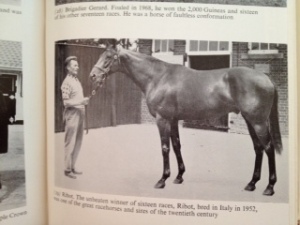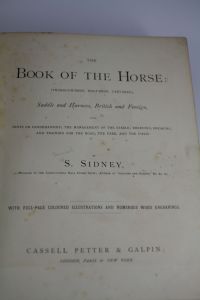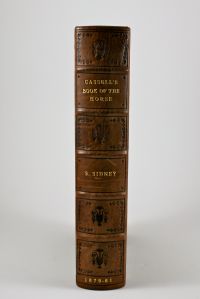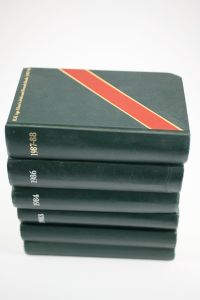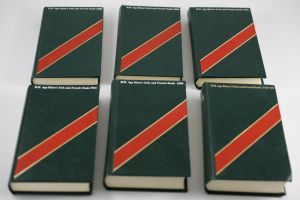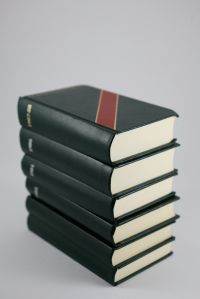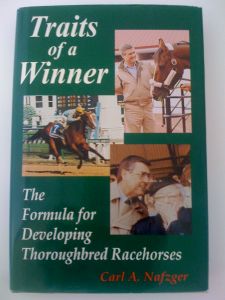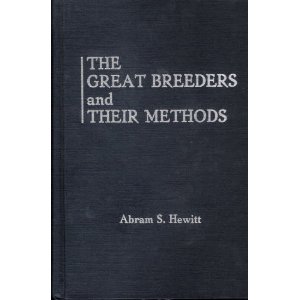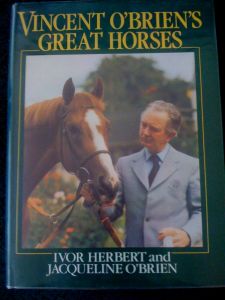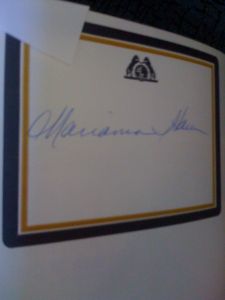The full title of Cassell’s Book of the Horse is The Book of the Horse: (Thorough-bred, Half-bred, Cart-bred), Saddle and Harness, British and Foreign, with Hints on Horsemanship; The Management of the Stable; Breeding, Breaking, and Training for the Road, the Park, and the Field. This is the oldest book in this collection of books on horses and horse racing, dated on the spine 1879-81, and written by Samuel Sidney (S. Sidney). Throughout this 604 page book are beautiful, vibrant, “full-page coloured” illustrations of horses, which you can also find reprinted and framed various places online. Nothing is quite as good as the images in the book though, which are amazing still, especially given their age. There are also numerous beautiful wood engravings throughout.
Contents include 29 chapters on everything from estimates of annual expenses of a carriage and horses and the origin of the modern british horse to horsemanship, or the art of “equitation,” stable clothing, fodder, and work, and hunting. Other chapters discuss breeding , breaking and training, and veterinary information.
The book was published by Cassell Petter and Galpin at Belle Sauvage Works in London. John Cassell founded the British publishing company, putting out its first publication on July 1, 1848, and it remained in existence in one form or another until it was taken over by the Orion Publishing Group in 1998.
The book’s binding and cover is part brown leather and part green and brown marbleized paper, and there is no dust jacket. Someone wrote “Samuel” in pencil above the S. Sidney on the title page. I doubt it is a signature of any kind. I do not know if this is the original cover, or if it is, the book appears to have new endpapers. It looks like the inner part of the book is intact. There are some spots (probably foxing) at the beginning and end of the book. The beautiful illustrations throughout seem mostly in good condition, with vibrant colors, although the one across from the title page has some spots. Most have a tissue inserted to protect them.
If you’d like more information about this rare book, please leave a comment or contact me at postpositionsbooks@gmail.com. Previewing this post, I see how great the illustrations look, and I might take some more photographs of the beautiful illustrations and post them later.
I have 6 books, all titled H.H. Aga Khan’s Irish and French Studs, each from a different year (or two), 1980, 1981, 1983, 1984, 1986, and 1987-88. Each book provides detailed information about the Aga Kahn’s “Stallions, Brood Mares, Horses in Training, Yearlings and Foals” for that particular year. These books are in pristine condition, not sure if they have ever been used, as some of the bindings creak when opened, as if they never have been opened before. All have the year on the spine, except for 1980 and 1981.
On facing pages, each horse is described in detail, by full name, birth year, family tree, turf record, family record, and stud record. As the Aga Khan was one of the most successful, if not the most successful, breeders of all times, these books should prove to be invaluable.
1980 is 167 pages, plus an unnumbered section on Horses in Training, Yearling and Foals.
1981 is 205 pages, followed by the same unnumbered Horses in Training, Yearling and Foals section and then a section called “Produce of 1980” and then “Produce of 1981.”
1983 is 206 pages, followed by the same unnumbered Horses in Training, Yearling and Foals section and then a section called “Produce of 1982” and then “Produce of 1983.”
1984 is 276 pages – now all pages are numbered.
1986 is 307 pages, all numbered.
1987-88 is 316 pages, again all numbered.
I have written a couple of other posts on books about the Aga Khan, one on 75 Years: The Aga Khan’s Racing and Breeding Studs, 1922-1997, by Georg Lange, and the other on Stanley Jackson”s The Aga Khan: Prince, Prophet and Sportsman.
If you are interested in knowing more about these fascinating books, please contact me at postpositionsbooks@gmail.com.
I found a very extensive list of books on thoroughbreds, horse racing, breeding, and more, somewhat hidden on the Thoroughbred Heritage website. Titled Recommended Reading, the list contains quite a number of books that are in the collection that I have for sale. Thoroughbred Heritage is sponsored by The National Sporting Library, a research center for horse and field sports, and contains information on breeding lines, portraits, genetics, and more.
The National Sporting Library just opened a museum, in historic Middleburg, Virginia. They also have an interesting page on their website for Book and Film Reviews. Both the Thoroughbred Heritage website and The National Sporting Library have lots of information on the horse and are worth a look.
As for Thoroughbred Heritage’s extensive bibliography, I have 57 books on the list and have already sold 14 others. Even reading their titles gives a good overall impression of the depth and breadth of books on thoroughbreds, racing, and breeding. Here are the 57 I currently have:
1 Backyard Race Horse: The Training Manual; A Comprehensive off-track program for owners and trainers., by Janet Del Castillo with Lois Schwartz, 1996 (3rd edition)
3 (Cassell’s) Book of the Horse: (Thorough-bred, Half-bred, Cart-bred), Saddle and Harness, British and Foreign, with hints on horsemanship; the management of the stable; breeding, breaking, and training for the road, the park, and the field, by Samuel Sidney, 1879 (very rare)
4 Bred to Run: The Making of a Thoroughbred, by Mike Helm, 1993 (2 copies)
5 Breeding To Race, by Sir Rhys Llewellyn, 1964
6 The Brigadier: The Story of Brigadier Gerard, by John Hislop, 1973
7 British Racing Prints, 1700-1940, by Charles Lane, 1990
8 The Byerley Turk: Three Centuries of the Tail Male Racing Lines, by K.M. Haralambos, 1990
9 The Classic Racehorse, by Peter Willett, 1989
10 Dark Horse: Unravelling the Mystery of Nearctic, by Muriel Lennox, 2001.
11 Development of Successful Thoroughbred Sire Lines in England and France, by Achille de Biase, 1961
12 Dr. Fager: Thoroughbred Legends, by Steve Haskin, 2000
13 Dynasties; Great Thoroughbred Stallions, by Edward L. Bowen, 2000
14 English Racing Stables, by Andrew Sim, 1993
15 Estes Formula for Breeding Stakes Winners, by Joseph A. Estes, 1998
16 Famous Running Horses, Their Forebears and Descendants, by Colonel John F. Wall, 1949
17 The First Century: Daily Racing Form Chronicles 100 years of Thoroughbred Racing, by Joe Hirsch, 1996
18 Fred Archer: His Life and Times, by John Welcome, 1967
19 Great Breeders & Their Methods, by Abram S Hewitt
20 Great Racehorses of the World, by Roger Mortimer and Peter Willett, 1969
21 A History of the English Turf 1904-1930: Supplementary to the History of the English Turf by Sir T.A. Cook, Volumes 1 and 2, by Captain T.H. Browne, 1931 (2 books)
22 The Horse Traders; Inside the billion dollar breeding industry that rules racing today, by Steven Crist, 1986
23 Hyperion, Introduced by The Earl of Derby and edited by Clive Graham, 1967 (first edition) (2 copies)
24 In Search of Shergar, by Colin Turner, 1984
25 International Stallions and Studes: The Founders of Modern World Racing, By Michael Seth-Smith, 1974
26 An Introduction to the Thoroughbred, by Peter Willett, 1975
27 Joe Taylor’s Complete Guide to Breeding and Raising Racehorses: Advice from America’s Master Horseman, by Joseph Lannon Taylor, 1993
28 Man O’War, by Page Cooper and Roger L. Treat, 1950 (first edition)
29 More Great Racehorses of the World, by Roger Mortimer and Peter Willett, 1972
30 My Story, by Sir Gordon Richards, 1955
31 The Names They Give Them, compiled by J.B. Faulconer, edited by Jim and Suzanne Bolus, 1998
32 Nashua: Racing’s High-Society Horse (Thoroughbred Legends series, #8), by Edward L. Bowen, 2001
33 Nijinsky: Blue Riband Sire, by Lesley I. Sampson, 1985
34 Northern Dancer: The Legend and His Legacy, by Muriel Lennox, 1995 (3 copies, including one with a Publisher’s bookplate stuck to inside front cover, with the signature: “Marianna Haun,” who analyzed and wrote about Northern Dancer in her second book on the X-factor)
35 Pedigrees of Leading Winners 1960-1980, compiled by Martin Pickering and Michael Ross, 1981
36 Reflections in a Silver Spoon: A Memoir, by Paul Mellon with John Baskett, 1992
37 The Science of Bloodstock Breeding, by B. Vijay, 1991
38 Secretariat, by Raymond G. Woolfe, 1998 (signed)
39 Sires of Winners: The stallion side of breeding and racing, by Richard C Templer, 1949
40 A Sound of Horses: The world of racing from Eclipse to Kelso, by David Alexander, 1966 (first edition)
41 Spectacular Bid: Racing’s Horse of Steel (Thoroughbred Legends series, #9), by Timothy T. Capps, 2001
42 Stud: Adventures in Breeding, by Kevin Conley, 2002
43 Sunday Silence: Racing’s Hard Luck Hero (Thoroughbred Legends series, #12), by Ray Paulick, 2001
44 The Tesio Myth, Frank Varola, 1984 (first edition)
45 The Tesios as I Knew Them, by Mario Incisa Della Rochetta, 1940 (signed, inscribed)
46 That’s Racing, edited by Peter O’Sullevan and Sean Magee, forward by HRH The Princess Royal, 1996
47 Thoroughbred Champions: Top 100 Racehourses of the 20th Century, by The Staff of Blood-Horse Publications, 1999
48 Thoroughbred Pedigrees Simplified, by Miles Napier, 1973 (hard cover)
49 Thoroughbred Studs of Great Britain, by Alan Yuill Walker, 1991
50 Thoroughbred Style: Racing dynasties – the horses, the owners, the studs, by Anne Lambton and John Offen, with a foreword by The Rt. Hon. The Earl of Derby M.C.
51 Thoroughbred Types 1900-1925: Race Horses, Steeplechasers, Hunters, and Polo Ponies, by W.S. Vosburgh and others, 1926, edition of 250, of which this is #97.
52 Training Thoroughbred Horses, by Preston M. Burch, 1976
53 Traits of a Winner: The Formula for Developing Thoroughbred Racehorses, by Carl A. Nafzger, 1994
54 Treasures of the Bloodstock Breeders’ Review, by Miles Napier and Leon Rasmussen, 199o (2 copies)
55 Vincent O’Brien’s Great Horses, by Ivor Herbert and Jacqueline O’Brien, 1984
56 Wild Ride: The Rise and Tragic Fall of Calumet Farm, Inc., America’s Premier Racing Dynasty, by Ann Hagedorn Auerbach, 1995
57 The X Factor: What It Is & How to Find It: The Relationship Between Inherited Heart Size and Racing Performance, by Marianna Haun, 1997 (new and signed, on publisher’s bookplate)
Here are the ones that have already sold:
1 Champions: The Lives, Times, and Past Performances of the 20th Century’s Greatest Thoroughbreds
3 The Functional Development of the Thoroughbred
4 Horsetrader; Robert Sangster and the Rise and Fall of the Sport of Kings, by Patrick Robinson with Nick Robinson, 1994 (2 copies)
5 Lightning in a Jar (new), by W. Cothran Campbell and D. Wayne Lukas, 2000
6 Seabiscuit: Special Illustrated Collector’s Edition: An American Legend (new)
7 Shergar and the Aga Khan’s Thoroughbred Empire, by Richard Baerlein, 1985
8 Story of Kelso, 1965
9 Sunny Jim: The life of America’s most beloved horseman James Fitzsimmons, by Jimmy Breslin, 1962
10 Thoroughbred Breeding: Notes and Comments, by Mordaunt Milner, 1987
11 A Treatise on Thoroughbred Selection, by Donald Lesh, 1940
12 Understanding the Power of the X Factor: Patterns of Heart Score and Performance, by Marianna Haun, 2001
13 Upgrading Thoroughbred Families: Using the Guidelines Laid Down By Federico Tesio, by Jack Glengarry, 1995
14 The Will to Win: Ron Turcotte’s Ride to Glory, by Bill Heller, with Ron Turcotte, SIGNED by Ron Turcotte, 1992
I find these lists fascinating. Unless I find another list, this might be the last post on lists, and I’ll continue to post on specific books instead. Any requests?
For more information on any of the books, please contact me by leaving a comment or emailing postpositionsbooks@gmail.com.
A small number of books on horse racing were found on an overlooked bookshelf, and I’ll be getting them and adding them to the inventory. I just got 5 more (well, 6, though one sold very quickly), shown below:
Traits of a Winner: The Formula for Developing Thoroughbred Racehorses, by Carl A. Nafzger, 1994
Joe Taylor’s Complete Guide to Breeding and Raising Racehorses: Advice from America’s Master Horseman, by Joseph Lannon Taylor, 1993
Sires of Winners: The stallion side of breeding and racing, by Richard C Templer, 1949 (2 volumes) – a second copy of this highly recommended 2-volume set
Breeding To Race, by Sir Rhys Llewellyn, 1964
The Science of Bloodstock Breeding, by B. Vijay, 1991
As a continuation of one of my latest posts on the top 50 books on horse racing, as identified by John Randall and his colleagues at the Racing Post, the article also lists the “25 books that nearly made the grade.” I almost overlooked this list, which is at the bottom of Part 1, numbers 31-50 of the list, and I’m glad I noticed it recently. Randall does not provide descriptions of these 25 books, as he did with the top 50. Here are the three that are I have, with short descriptions based on my research.
#14 of the next best books on horse racing is The Brigadier: The Story of Brigadier Gerard, by John Hislop (1973). The dust jacket now is protected with a mylar cover, which is why there is a bit of reflection in the photograph. Hislop was the breeder of Brigadier Gerard, one of the best and most popular British Thoroughbred race horses of the 20th century, winning 17 of his 18 races, and in this book, he tells their story. As described on the inside of the dust jacket,
Now John Hislop tells how for years he and his wife had bred and raced horses on a modest income; of how his life’s ambition had been to acquire a brood mare from the family of the immortal race mare Pretty Polly; how he found such a mare at the Newmarket sales, paying only 400 gns. for her; and how as a result the Hislops, by sending her daughter La Paiva to an unfashionable stallion, produced from her a foal whom they were sure was a true champion. They were right, and the theory and practice of their achievement Mr. Hislop fascinatingly describes.
400 gns. (or guineas) is approximately $675. Interestingly, many race horses are still sold in guineas, which is the currency in which they were sold hundreds of years ago. There are a lot of great photographs of Brigadier Gerard throughout this fascinating book too.
#18 on this list is The Great Breeders and their Methods, by Abram Hewitt (1982). I wrote about this book in an earlier post. I’ll add that Hewitt wrote, about the breeders he discusses in the book:
However much experimenting and unplanned ‘mindless probing’ most of these breeders had to do before striking a winning vein, this would seem to be no longer wholly necessary for new breeders entering the field today. New breeders are in a position to study the breeding operations of their predecessors and to screen out the important features which were the foundation of great successes in the past.
Our earnest hope is that the more important of these features have been pointed out in the chapters in The Great Breeders and Their Methods, and that this may be of some possible help to present day and future breeders.
I can see how this book would be important in the field of horse racing and worth reading.
and #19 is Vincent O’Brien’s Great Horses, by Ivor Herbert and Jacqueline O’Brien (1984). Vincent O’Brien was an Irish race horse trainer, who was voted the greatest influence in horse racing history in The Racing Post’s 2003 world-wide poll. Herbert had full-cooperation of O’Brien in writing the book, and the trainer’s wife, Jacqueline O’Brien, is co-author, providing a lot of the background material. As described on the dust jacket,
This is the first inside account of sixteen of the most famous horses trained by Vincent O’Brien, from triple Gold Cup winner Cottage Rake to Irish Sweeps Derby winner El Gran Senor. In between gallop the like of Hatton’s Grace, Royal Tan, Ballymoss and Gladness, Sir Ivor, Nijinsky, The Minstrel, Alleged and Golden Fleece.
Both this book and The Brigadier give personal accounts of their authors’ lives in horse breeding and racing, providing unique insights into their successes. With Hewitt’s book, there is a lot of information about breeding and horse racing, supported by amazing photographs of the horses and breeders involved.
If you’d like more information on these books, please let me know.
In my last post, I wrote about a list of the best books on horse racing, as determined by racing historian John Randall and fellow Racing Post staff writers. Part 1 of the article mentions that Racing Post‘s list was “inspired by the US magazine Sports Illustrated, which in 2002 published a survey of the top 100 sports books of all time.” Part 1 of the Racing Post article also began the list of the top 50 best books on horse racing, from number 50 up, with number 50 being Seabiscuit, by Laura Hillenbrand (2001). This book is described in less than glowing terms:
This biography of the 68th-best American racehorse of the 20th century has achieved spectacular success but is vastly overrated. In relating the obstacles overcome by Seabiscuit and his connections, Hillenbrand is much more interested in myth-making than factual accuracy, notably in the absurd claim that her hero was the No. 1 newsmaker of 1938. She is a skilled story-teller but not a historian.
Since all the other books on Randall’s list are described with such amazing positive traits, tying them into the history and importance of horse racing literature, I wondered why Hillenbrand’s book was not given the same treatment. Then I looked at the Sports Illustrated article. I was excited to see which of the books on horse racing had made their list. Then I saw it. Amongst the books on football, baseball, boxing, and hockey, there was only one – #12 – Seabiscuit.
Sports Illustrated described the book more positively:
People who’ve never been to the racetrack love this book, and it’s easy to see why. Hillenbrand has an irresistible story to tell, about a homely hay burner who came to dominate the Depression-era sports pages, taking a colorful crew of humans along for the ride.[New York Times best-seller]
Perhaps the intent of the Sports Illustrated list is a little different, as they began, “Many of the country’s best writers have long been fascinated with sports, and that passion shows up in their prose. After all, when done right, sportswriting transcends bats and balls to display all the traits of great literature: incision, wit, force and vision, suffused with style and substance. Herewith the editors of SI’s favorite sports books, compiled with love and reason, out of intense and sometimes unruly discussions.”
Perhaps they went for more emotion, taking writing style and popularity into account, listing if a book was a New York Times best-seller and/or became a movie, not looking back into the broadness of a sport as Randall and his fellow writers did. And perhaps Hillenbrand’s ability to make a story about horse racing enticing to those who never go to the track is admirable and noteworthy. Randall’s list took on a new perspective for me though, as more of a response to the Sports Illustrated article, outlining the greatness of the writing on just one sport, by someone who had the opportunity to go into the depth of writing and history of that one sport beyond the popular literature of the time. Randall’s list, in three parts, then becomes an important document in itself about the history of horse racing, worth re-reading, savoring, and not forgetting.
(By the way, in the Sports Illustrated list, Seabiscuit comes right after one of my favorite books, about fly fishing and family, A River Runs Through It, by Norman Maclean, which I also highly recommend.)
I’ve been intrigued by lists of horse racing books. Unfortunately, I haven’t been able to find many. The lists I have found feature books covering the history of racing, breeding techniques, infamous races, and biographies of owners, breeders, trainers, and horses. The list I looked at most recently is by racing historian John Randall, written for the UK’s Racing Post with staff writers Tony Morris and Robin Gibson in 2005, listing his top 50 of the best racing books ever written.
The article is written in 3 parts, with Part 1 “Counting down the best 50 books on the Sport of Kings Today: numbers 50-31,” Part 2 continuing with books 30-11, and concluding with Part 3, the “Ten masterpieces that represent the pinnacle of Turf literature.” For each book, he and the other Racing Post writers give a short, compelling description about why this book has made the list.
As Randall writes,
The literature of the Turf is richer and more varied than that of any other sport, and well over 10,000 books on racing have been published in the 2,400 years since Xenophon wrote The Art of Horsemanship… A mixture of popular and academic works, golden oldies and recent hits, they reflect the scope and unique flavour of the sport, and give a vivid and original treatment of their subject matter.
Although most of the books on the list are British or Irish, some are French, German, or American. Randall continues, “The 50 chosen titles represent the whole spectrum of Turf literature – not just histories, biographies and encyclopaedias, but also fiction, journalism, books about breeding, gambling, sociology, politics and anthropology, humorous works, and even one instruction manual.”
Purposely excluded from the list are annuals and other periodical publications, such as Timeform annuals, Bloodstock Breeders’ Reviews, Racing Calendars, Stud-Books, Ruff’s Guides, Statistical Records and Directories of the Turf, “without which no serious racing library is complete.”
I have 5 of the books in this list – 6 if you count my paperback copy of Seabiscuit, by Laura Hillenbrand (2001), #50 on this list, not favorably described by Randall (even though it still made the list):
“This biography of the 68th-best American racehorse of the 20th century has achieved spectacular success but is vastly overrated. In relating the obstacles overcome by Seabiscuit and his connections, Hillenbrand is much more interested in myth-making than factual accuracy, notably in the absurd claim that her hero was the No. 1 newsmaker of 1938. She is a skilled story-teller but not a historian.”
Counting up to the top book, I also have #43 on the list, The Aga Khan’s Racing and Breeding Studs 1922-1997, by Georg Lang (1998):
“No stud since 1900 has been more important than that of the Aga Khans, III & IV. Any enthusiast might have dug out the information necessary to compile this book, but nobody could have presented it better and produced it in a better format than Georg Lange. This is a superb example of assiduous research on a crucial subject. Aga Khan-breds infuse pedigrees worldwide; this German book shows us just how significant that influence is.” Note that although this book is published in Germany, it is written in English.
#39 Stud Book Lore, by Charles Prior and Florence Prior (1951) is described:
“So much of racing history would have been lost but for the work of Charles Prior and his daughter Florence.
No less should we be grateful to the editors of the newspapers and magazines in which the articles in this anthology were first published between 1904 and 1938. There is no print outlet, in a periodical, for such material these days, and one is bound to wonder how such gifted writers and researchers would have coped with the internet, the only outlet for their knowledge and expertise in the modern world.”
In #27 on the list, Wild Ride, by Ann Hagedorn Auerbach (1994), subtitled The Rise and Tragic Fall of Calumet Farm, Inc., America’s Premier Racing Dynasty, “this piece of investigative reporting tells how the once-supreme Kentucky stud and stable was bankrupted under the stewardship of J T Lundy between 1982 and 1991. One reads with appalled fascination at how so much money could be squandered so fast, at the mysterious death of Calumet’s prize stallion Alydar, and at the sheer greed and corruption on display. This, not Seabiscuit, is the best racing book by an American authoress.”
I also have #24, Bloodstock Breeding, by Sir Charles Leicester (1957). As the article states, “Charles Leicester’s magnum opus did not deal only with the Derby winners of the 20th century up to his time, but it was his analysis of their pedigrees that provided the main focus of his work, and it was extraordinarily well researched. The sires and dams were just a part of it; he wrote about other aspects of the pedigrees, and could always be trusted to be accurate. He just presented facts and left readers to make their own judgments, and in those terms it remains hard to fault. A second edition, revised by Howard Wright, was published in 1983.” I also have a copy of the 1983 revision.
I have one book from the top 10 masterpieces, An Introduction to the Thoroughbred, by Peter Willett (1966, though my copy is from 1975). Describing this masterpiece, the article says, “There have been many books written about breeding, and plenty since this one appeared. And geneticists have lately uncovered numerous facts that were not available to Peter Willett when he wrote this book. But there is still no better primer. This is an area that has generated countless theories, most of them worthless, and until genetics gives us all the answers – with luck, a long time in the future – the breeder’s safest methodology is applied commonsense. Willett does not say that in so many – or so few – words, but he runs the rule over theories and practices, and he describes, lucidly and logically, what makes sense and what doesn’t. It is a shame that a lot of the books on breeding that have appeared recently have – apparently – been written by people who have not read this seminal work. Students of breeding are best advised to read this one first; they will be better informed than those who have ignored it. ”
Reading all three parts Randall’s list, which was based on the 2002 Sports Illustrated list of the best sports books of all time, and the description of each book brings out the excitement of racing and the complexity of the sport and its history.
P.S. Here is a bit more on John Randall, from the Directory of the Turf: “b. 20.4.53. Career: Author of historical articles and obituaries. Raceform 1977-85, Racing Post 1986-. Other details: Co-Author with Tony Morris of Horse Racing: Records, Facts & Champions, 1990, A Century of Champions, 1999, author of four Raceform Quiz Books, 1986-89, compiler of questions for BBC Mastermind, contributor to Notable English & Irish Thoroughbreds, Oxford Dictionary of National Biography. Other details: Winner of £500,000 <over $800,000 U.S.> on Who Wants to be a Millionaire? 2000.”
Now that I’ve posted all the books in the collection on the inventory page, I wanted to identify the ones that are signed. Please post a comment if you would like more information.
75 Years – The Aga Khan’s Racing and Breeding Stud, 1922-1997, compiled and published by Georg Lange, Germany, 1998 (signed, book #319 out of 333)
How to Breed a Racehorse, by Michael Miller (signed), 1951
Inbreeding to Superior Females Using the Rasmussen Factor to Produce Better Racehorses, by Rommy Faversham and Leon Rasmussen (signed, inscribed), 1999
Secretariat, by Raymond G. Woolfe, 1998 (signed)
The Tesios as I Knew Them, by Mario Incisa Della Rochetta, 1940 (signed, inscribed)
Understanding the Power of the X Factor: Patterns of Heart Score and Performance, by Marianna Haun, 2001 (Publisher’s bookplate, signed “Marianna Haun,” on inside front cover.) (Since I first posted this photo, this book has sold & is no longer in the collection.)
The X Factor: What It Is & How to Find It: The Relationship Between Inherited Heart Size and Racing Performance, by Marianna Haun, 1997 (new, tight binding, and signed, on publisher’s bookplate)
Soon I’ll write more about the books in the collection. Some good ones are being added, with great information on the history of horse racing and various related subjects. Not sure yet which one is my favorite.


